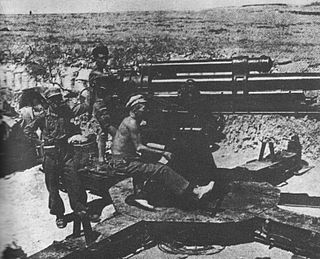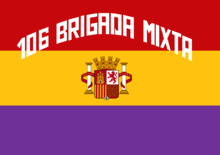
Gandesa is the capital of the comarca of Terra Alta, in the province of Tarragona, Catalonia, Spain.

The Battle of the Ebro was the longest and largest battle of the Spanish Civil War and the greatest, in terms of manpower, logistics and material ever fought on Spanish soil. It took place between July and November 1938, with fighting mainly concentrated in two areas on the lower course of the Ebro River, the Terra Alta comarca of Catalonia, and the Auts area close to Fayón (Faió) in the lower Matarranya, Eastern Lower Aragon. These sparsely populated areas saw the largest array of armies in the war. The battle was disastrous for the Second Spanish Republic, with tens of thousands left dead or wounded and little effect on the advance of the Nationalists.

The Fuerzas Regulares Indígenas, known simply as the Regulares (Regulars), are infantry units of the Spanish Army, largely recruited in the cities of Ceuta and Melilla. Historically, the force, which has also included mounted divisions, has consisted of Berbers officered by Spaniards. The troops served as the indigenous component of the Army of Africa and played a significant role in the Spanish Civil War (1936-1939).

The siege of Madrid was a two-and-a-half-year siege of the Republican-controlled Spanish capital city of Madrid by the Nationalist armies, under General Francisco Franco, during the Spanish Civil War (1936–1939). The city, besieged from October 1936, fell to the Nationalist armies on 28 March 1939. The Battle of Madrid in November 1936 saw the most intense fighting in and around the city when the Nationalists made their most determined attempt to take the Republican capital.
Sebastián Pozas Perea was a Spanish military officer and civil servant.

The Aragon Offensive was an important military campaign during the Spanish Civil War, which began after the Battle of Teruel. The offensive, which ran from March 7, 1938, to April 19, 1938, smashed the Republican forces, overran Aragon, and conquered parts of Catalonia and the Levante.
Songs of the Spanish Civil War were folk songs and anthems brought by fighters on both sides of the War. The songs were adapted into marching songs, or sung around campfires.

"¡Ay Carmela!" is one of the most famous songs of the Spanish Republican troops during the Spanish Civil War.

The XI International Brigade fought for the Spanish Second Republic in the Spanish Civil War.
The Extremadura campaign was a campaign in Extremadura, Spain during the Spanish Civil War. It culminated in the Battle of Badajoz in August 1936, from which the troops of the Army of Africa under the command of Francisco Franco moved quickly to begin the march to Madrid.
The First Battle of the Corunna Road took place between 29 November and 3 December 1936 during the Spanish Civil War. The Nationalists tried to isolate Madrid from the west, cutting the Corunna Road, but the Republican army repelled the attack.
The Battle of Lopera took place between 27 and 29 December 1936 during the Spanish Civil War. This battle took place during the Nationalist's Aceituna offensive. On 27 December, the XIV International Brigade launched an attack in order to occupy the Nationalist-held town of Lopera, but the attack failed after two days and the Brigade suffered appalling casualties.
The Battle of Alfambra took place near Alfambra from 5 to 8 February 1938, during the Spanish Civil War. This battle was a part of the Battle of Teruel. After, the conquest of Teruel by the Republican army, the Nationalists started a counteroffensive in order to reocuppy Teruel. On 5 February a huge nationalist force broke the republican lines north of Teruel towards the Alfambra river, taking 7,000 republican prisoners and threatening the Republican forces in Teruel.
The Battle of Caspe took place during the Aragon Offensive of the Spanish Civil War in 16–17 March 1938.
The siege of Gandesa took place between July and November 1938 during the Spanish Civil War, a few months after a battle in the same town.
Fernando Barrón y Ortiz (1892–1952) was a Spanish military officer. One of the five commanders of the natives troops in Africa, he supported the military coup of July 1936 which started the Spanish Civil War. Later, he was one of the commanders of the Spanish Army of Africa in its advance towards Madrid. In November 1936 led the nationalist attack against the Madrid's suburb of Carabanchel. In December 1936 he led one of General Varela's mobile columns in the Second battle of the Corunna Road. In January 1937 he led a brigade in the Battle of Jarama. In May 1937, he took part in the nationalist counteroffensive during the Segovia Offensive. In June 1937, he led the 13th division in the Battle of Brunete in August in the Battle of Belchite and in March 1938 in the Battle of Caspe. During the Battle of the Ebro he led the Nationalist defense of the town of Gandesa. After the war, he was a minister of the Francoist government.

The 3rd Mixed Brigade, was one of the earliest mixed brigades of the Spanish Republican Army in the Spanish Civil War. It was formed in the fall of 1936 with battalions of the Carabineros corps and saw major action right away in the Defence of Madrid. This brigade also included female combatants —such as Sergeant "La Chata"— and would take part in most of the major battles of the Spanish Civil War, except in the Battle of Jarama.

The 87th Mixed Brigade, was a mixed brigade of the Spanish Republican Army in the Spanish Civil War. It was formed in March 1937 with battalions of the Carabineros corps. Its first commander was Infantry Colonel Carlos Amores Cantos, who was succeeded by Militia Major Andrés Nieto Carmona.
The 81st Mixed Brigade was a unit of the Spanish Republican Army created during the Spanish Civil War. It operated on the Teruel, Levante and Estremadura fronts.
The XII Army Corps was a military formation belonging to the Spanish Republican Army that fought during the Spanish Civil War. Formed by veteran units, throughout the war it took part in prominent intervention in some of the main battles of the war, such as Aragon or the Ebro.








